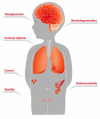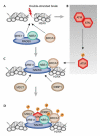ATM and ataxia telangiectasia
- PMID: 15289825
- PMCID: PMC1299121
- DOI: 10.1038/sj.embor.7400210
ATM and ataxia telangiectasia
Abstract
Ataxia telangiectasia (AT) has long intrigued the biomedical research community owing to the spectrum of defects that are characteristic of the disease, including neurodegeneration, immune dysfunction, radiosensitivity and cancer predisposition. Following the identification of mutations in ATM (ataxia telangiectasia, mutated) as the underlying cause of the disease, biochemical analysis of this protein kinase has shown that it is a crucial nexus for the cellular response to DNA double-stranded breaks. Many ATM kinase substrates are important players in the cellular responses that prevent cancer. Accordingly, AT is a disease that results from defects in the response to specific types of DNA damage. Thus, although it is a rare neurodegenerative disease, understanding the biology of AT will lead to a greater understanding of the fundamental processes that underpin cancer and neurodegeneration.
Figures



References
-
- Abner CW, McKinnon PJ (2004) The DNA doublestrand break response in the nervous system. DNA Repair (Amst) (in press) - PubMed
-
- Angele S et al. (2003) ATM haplotypes and cellular response to DNA damage: association with breast cancer risk and clinical radiosensitivity. Cancer Res 63: 8717–8725 - PubMed
-
- Baker SJ, McKinnon PJ (2004) Tumoursuppressor function in the nervous system. Nat Rev Cancer 4: 184–196 - PubMed
-
- Bakkenist CJ, Kastan MB (2003) DNA damage activates ATM through intermolecular autophosphorylation and dimer dissociation. Nature 421: 499–506 - PubMed
-
- Barlow C, Liyanage M, Moens PB, Deng CX, Ried T, Wynshaw-Boris A (1997) Partial rescue of the prophase I defects of Atm-deficient mice by p53 and p21 null alleles. Nat Genet 17: 462–466 - PubMed
Publication types
MeSH terms
Substances
LinkOut - more resources
Full Text Sources
Other Literature Sources
Medical
Research Materials
Miscellaneous

